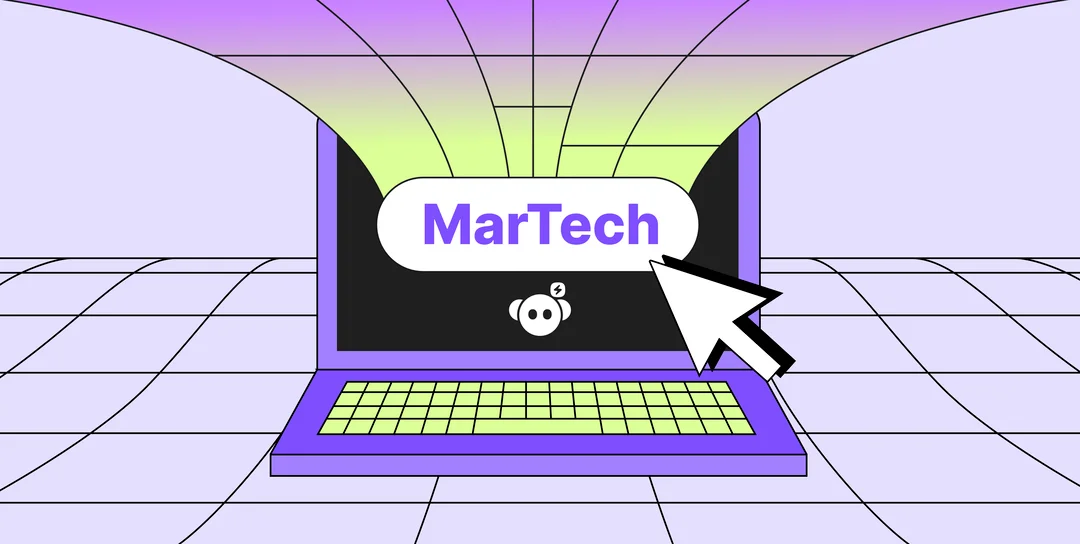Martech Stack: Definition, Benefits, and Applications
• Customer Support
• FastBank

Imagine trying to build a house with only a hammer - it's possible, but it'll take forever. That's marketing without a marketing technology stack or martech stack. If you're unfamiliar with the term, martech refers to the bundle of tools, platforms, and software used to boost marketing operations and results.
Today, marketers need such tools to bring their creative ideas into life and do so at lightning speed. A carefully collected marketing stack can automate, personalize, and optimize marketing strategies and instill precision and ease into processes.
That's the true power of a martech stack-it's like upgrading from a hammer to a full set of power tools. But how does this toolkit really work, and why is it a marketer's secret weapon? To understand its true impact, let's first uncover what a marketing tech stack is and how it's transforming the way marketing teams operate.
What is a Martech Stack?
A martech stack, short for marketing technology stack, is a collection of tools and platforms marketers use to streamline and enhance their marketing efforts. The stack includes a variety of marketing automation tools, marketing software, and other marketing strategies.
Essentially, it integrates different marketing tools to automate processes, analyze data, and manage campaigns more efficiently. From email marketing and customer relationship management (CRM) systems to analytics and social media management, each component plays a crucial role in modern marketing.
The importance of a well-structured marketing tech stack cannot be overstated. In an era where data drives decision-making and customer expectations are higher than ever, having the right mix of marketing technologies is essential for staying competitive. A robust marketing technology stack enables marketers to automate repetitive tasks, saving time, reducing errors, and enhancing campaign consistency. It provides powerful analytics that help understand customer behavior, optimize marketing strategies, and measure ROI more effectively.
Why Is a Marteck Stack Important?
The importance of a well-structured marketing tech stack cannot be overstated. In an era where data drives decision-making and customer expectations are higher than ever, having the right marketing technologies stack is essential for staying competitive. A robust marketing technology stack helps marketers with the following functions:
-
Automates repetitive tasks, saving time and reducing errors
-
Enhances campaign consistency
-
Provides powerful analytics to understand customer behavior
-
Helps optimize marketing strategies
-
Measures ROI more effectively
Essential Components of a Successful Martech Stack
A winning marketing technology stack is like a dynamic team, where each component brings its unique strengths to the table to enrich your marketing arsenal. So, here's a brief overview of each of those components:
1. Marketing Automation Tools
Marketing automation tools streamline repetitive tasks like email campaigns, social media posting, and lead nurturing. By automating these processes, marketers can focus on strategy and personalization, improving customer engagement and conversion rates. These tools help ensure consistent communication with audiences while tracking interactions to better target future efforts.
2. Customer Relationship Management (CRM) System
A CRM system organizes and manages customer data, interactions, and relationships in one place. It enables businesses to track leads, close deals, and maintain long-term relationships by having access to all customer touchpoints. You may, "What role can a CRM play in an effective martech stack?" Good question! With a CRM, teams can collaborate more effectively, ensuring no opportunity is missed while improving overall customer satisfaction.
3. Analytics and Reporting Tools
Analytics tools provide valuable insights into the performance of marketing campaigns, customer behavior, and website traffic. By tracking key metrics, marketers can identify trends, optimize strategies, and make data-driven decisions. Reporting tools also help showcase results to stakeholders, ensuring marketing efforts align with business goals.
4. Content Management System (CMS)
A CMS allows businesses to easily create, manage, and modify digital content without extensive technical knowledge. It's essential for building and maintaining a website, ensuring content is updated regularly and presented effectively. With a user-friendly CMS, marketers can quickly publish new content, improving SEO and keeping audiences engaged.
5. Data Integration Platforms
Data integration platforms bring together information from various sources, ensuring all tools and systems work in sync. By connecting different data streams, businesses can gain a unified view of customer behavior, improving decision-making and personalized marketing. These platforms help eliminate data silos, making it easier to access and act on important insights.
6. Ad Tech Solutions
Ad tech solutions are tools that manage and optimize digital advertising campaigns across multiple platforms. They help marketers target specific audiences, track campaign performance, and maximize return on ad spend. By using these solutions, businesses can efficiently reach their audience through paid ads, increasing brand visibility and driving conversions.
How to Build a Martech Stack?
When building a martech stack, it's crucial to avoid selecting random tools and, instead, make deliberate choices that align with your specific needs and goals. Here's a practical checklist guiding you on how to pick the right marketing tech stack for your business:
1. Define Your Marketing Objectives
Identify what you want to achieve - whether it's increasing sales, improving customer retention, or enhancing brand awareness. Your goals will directly influence the types of martech tools you need, as each tool offers unique functionalities that cater to different marketing objectives. For example, if sales are your focus, tools for lead generation and conversion optimization will be essential. Thus, clarifying your goals ensures you invest in the right tools and drive desired outcomes.
2. Assess Your Current Tools and Gaps
Review the tools you already use, such as marketing automation tools and CRM systems. Determine what's missing or what could be improved to meet your goals more effectively. Look for gaps where your existing tools may be falling short in helping you achieve your goals. Identifying these areas for improvement or addition will help you decide which new tools you should incorporate into your martech stack.
3. Choose Tools Based on Specific Needs
Look for tools that address your core needs. For instance, if you need better customer segmentation and personalized communication, consider marketing software that offers advanced data analysis and targeted campaign features. Tools with machine learning and AI-powered insights can analyze customer behavior patterns and provide recommendations for personalized messaging. These tools can also help you segment your audience based on various criteria, such as demographics, purchasing habits, or engagement history, allowing you to tailor campaigns to each group's unique needs.
4. Ensure Integration and Compatibility
Verify that the tools you select can integrate smoothly with each other. Choose platforms that offer robust integration options, such as pre-built connectors or APIs, to ensure smooth data flow between systems and help you avoid manual data entry. With seamless integrations, you can automatically sync customer data, track interactions across channels, and create a unified view of your marketing performance.
5. Plan for Data Management
Implement a customer data platform (CDP) if you need to consolidate and manage customer data from multiple sources. It enables you to unify customer information from various touchpoints - such as website interactions, social media, email campaigns, and in-store visits. This helps create comprehensive customer profiles and improve targeting.
6. Monitor and Optimize
Regularly track the performance of your marketing tech stack. Use analytics tools to review key metrics such as customer engagement, conversion rates, ROI, and campaign performance. Additionally, gather feedback from your marketing team and other stakeholders to understand any challenges or limitations that they may be facing with the current tools.
What Role Can a CRM Play in Effective Martech Stack?
When you bring a CRM into your marteck stack, it syncs up all your other tools - email platforms, social media tools, you name it. This lets you automate tasks, monitor customer engagement, and really fine-tune your campaigns based on actual data.
By centralizing all your customer data, a CRM gives you a clear, unified view of your audience, allowing you to create more personalized and targeted marketing strategies. You can analyze customer behavior across channels, adjust campaigns in real-time, and deliver the right message to the right person at exactly the right time.
Must-Have Martech Tools and Software
As stated, a strong marketing technology stack relies on the right tools to automate, track, and enhance your marketing efforts. Here are essential martech platforms and martech stack examples that can help streamline your processes and drive better results.
-
Hoory AI: All-in-one platform for automating customer support operations and managing customer interactions.
-
Google Analytics: Tracks website traffic, user behavior, and campaign performance to inform data-driven decisions.
-
Mailchimp: Easy-to-use email marketing tool for sending newsletters, promotions, and automated follow-ups.
-
Hootsuite: Schedules and manages social media posts across multiple platforms from one dashboard.
-
Ucraft: Popular eCommerce website builder for creating and managing websites, blogs, and digital content.
-
Zapier: Connects different apps and tools to automate workflows and integrate data without needing code.
-
Google Ads: A robust platform for creating, managing, and optimizing online ad campaigns across Google’s network.
-
Localo: An intuitive local SEO tool powered by AI that helps businesses optimize Google Business Profiles, track keyword performance, and enhance visibility in local searches.
Conclusion
Just like upgrading from a hammer to a full set of power tools transforms how you build a house, a martech stack revolutionizes the way marketers execute their strategies. With the right combination of tools, marketing becomes less about manual effort and more about smart automation, personalization, and data-driven decisions.
By integrating these tools into a cohesive system, marketers can focus on what truly matters: impactful campaigns, customer engagement and consistent growth.

























